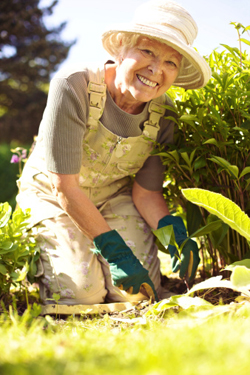 November 20, 2014, is "Use Less Stuff Day"— an annual reminder that we all must reduce our consumer footprint in order to promote more sustainable methods for living. But environmental activism and conscientiousness aren't the exclusive provinces of the young. Even those living in retirement can take steps to go green and reduce waste.
November 20, 2014, is "Use Less Stuff Day"— an annual reminder that we all must reduce our consumer footprint in order to promote more sustainable methods for living. But environmental activism and conscientiousness aren't the exclusive provinces of the young. Even those living in retirement can take steps to go green and reduce waste.
It's probably easier, in fact, for seniors to be more environmentally conscious than it is for younger people. Adults of working age are often beholden to long, daily commutes that could not be made without fossil-fuel dependent cars. Their hectic schedules allow less time for food preparation at home.
Naturally, that's not to say that younger adults shouldn't be trying to reduce their impact on the environment, but it can certainly be true that many seniors have the luxury of spending more time practicing environmentally-sound habits.
Here are five simple steps you can take to enjoy a greener senior lifestyle… and set a good example for succeeding generations.
1. Garden at home.
Many older adults already enjoy gardening in their spare time. One of the ways to be more green, of course, is to work out that green thumb and grow your own fruits and vegetables. This reduces demand for store-bought produce, which must be trucked from the farm to the grocery— often over long distances— refrigerated, or preserved.
Gardening doesn't have to be strenuous, either. If you have arthritis or don't get around so well anymore, even a small window box garden can produce enough vegetables to sustain one or two people through a growing season: no plowing, no digging, no kneeling and no hassle.
Growing and consuming your own produce also reduces your dependency on high-sodium, high-sugar processed foods — long-associated with an increased risk of high blood pressure, heart disease, strokes and diabetes — and provides better nutrition to can keep you healthy longer.
2. Compost your kitchen and paper waste.
If you are gardening, composting is an excellent way to both reduce the amount of waste your household produces and to fertilize your plants. Coffee grounds, for example, provide much-needed nitrites that plants need to grow. Used oils and leftover food greases, which can otherwise be inadvertently washed into the water treatment system (where they block lines and cause major municipal headaches), can be composted right along with organic table scraps, yard waste and garden clippings to recycle nutrients back into your topsoil. It's easy to build a composting bin, too, as illustrated here.
3. Walk or bicycle when you run your errands.
Firing up the sedan to drive a mile down to the store is incredibly wasteful of gasoline. You could just as easily get there and back under your own power. Moreover, biking and walking daily are excellent ways to stay in good physical shape. Save the car for a rainy day— use caloric power to get you where you need to go when the weather's nice.
4. Air out your laundry.
An electric or gas-powered dryer uses a lot of energy. But Mother Nature can just as easily do the work for you. Put up an old-fashioned clothesline and dry your raiment en plein air instead! You'll reduce your carbon footprint, your clothes will smell fresh and clean and you can save all that money you'd otherwise spend on dryer sheets and energy use.
5. Downsize your residence.
Once the kids are gone, do you really need that 5-bedroom, 2 ½-bath mini-mansion, and all the stuff you store in it? Sell off some of your unneeded belongings and move into a smaller, more energy-efficient home.
A ranch-style home can be cheaper to heat in the winter and cool in the summer. Moving to a single-floor home plan can also help you to plan for future special mobility needs, such as the need to use a walker or a wheelchair to get around, as you age. Or, you could even consider moving into a LEED-certified retirement community.
Going green doesn't mean giving up comforts.
It just means being smarter about the amount of waste you create as a consequence of daily retirement living. If you don't need to use something, find a more environmentally-friendly alternative, or try to do without it entirely. By setting a good example of conscientious consumerism, you can help humanity to live more sustainably and harmoniously.












